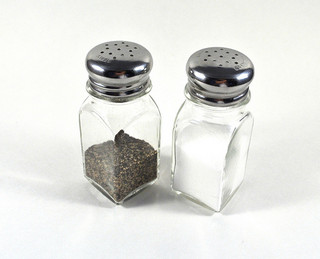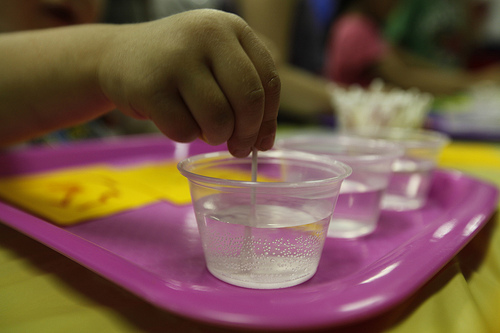My oldest son used to put on shows using science to create illusions for his friends. When his younger brother was just 4, he would pretend to make him disappear. Of course, the audience figured this trick out easily—when the 4-year-old waved to them from behind the tablecloth!
It’s fun to watch an illusionist and try to discover how he performs his tricks! That disappearing trick was based on distraction of the audience and not on science. However, when an illusion is based on science, it very rarely fails. Why do you think science tricks rarely fail? It is because God created an order to this world, and God’s order is what science is based upon. So if you want to baffle your friends, try the science projects below.
Project #1: The Levitating Seasoning
Items Needed
• Coarse salt
• Ground pepper
• Plastic spoon
• Wool scarf
Begin this science trick by mixing salt and pepper on a flat surface. Ask your audience if they think they can separate the pepper from the salt with a plastic spoon. If someone volunteers, let him try for a few seconds (but don’t be too hard on him). Then, pull out the wool scarf and rub the plastic spoon quickly back and forth upon it. Next, hold the spoon about ½ in.–1 in. above the salt and pepper mixture. The pepper should jump up onto the bottom of the spoon.
Why Does This Happen?
When you rub the plastic spoon, it gains a static charge, which attracts the pepper. The salt is also attracted, but because it is heavier, it cannot rise like the pepper.
Project #2: The Jumping Coin
Items Needed
• Bowl of cold water
• Glass soda bottle with a small mouth
• Coin, slightly larger than the bottle’s mouth
Begin this science illusion by placing both the soda bottle and the coin into the bowl of cold water. (Be aware that you do not want any of the cold water to go into the bottle.) Next, take both items out of the cold water, and place the coin on top of the bottle. You may now hold the bottle near the bottom with your cupped hands surrounding it. The coin should look like it is jumping up and down on the mouth of the bottle.
Why Does This Happen?
When the bottle and the coin are placed in the cold water, they both become cold. When you hold the bottle in your warm hands, they begin to warm both the bottle and the air inside it. When the air gets warmer, it moves around faster and pushes up on the coin at the mouth of the bottle. Because of this, when the air cools down, the coin stops jumping.
Project #3: The Toothpick Triangle
Items Needed
• Four (or more) flat wooden toothpicks
• Bowl of water
• Dish detergent
Carefully place three toothpicks onto the surface of the water so they touch one another in the shape of a triangle. It may take some practice to achieve this, but the toothpicks will float in the design of a triangle when placed correctly. Once you have accomplished this, dip one end of the fourth toothpick into dish detergent. (If you are doing this to baffle your friends, you should have the fourth toothpick already dipped in detergent prior to their arrival and set aside.)
To achieve the science trick, touch the soaped end of the toothpick into the water in the middle of the triangle. The toothpick triangle should break apart when the fourth toothpick touches the water.
Why Does This Happen?
All things created are made up of molecules. The water molecules in the bowl stick together to form an invisible layer on the surface called surface tension. It is the surface tension of the water on which the flat toothpicks float. When you touch the toothpick with detergent into the water, the soap molecules break the surface tension. The breaking of surface tension pushes the other toothpicks out where the surface tension has not yet been affected.
Once the soap molecules are introduced to the bowl, the surface tension will not come back. If you want to repeat this science trick, you will have to rinse the bowl out and use new toothpicks.
Project #4: Invisible Inks
Items Needed for Ink 1
• Paper
• Lemon juice
• Cotton swab or small paintbrush
• Warm lightbulb, warm oven, or other heat source
To create Ink 1, write a message onto the paper with lemon juice. Allow the juice to dry completely. With your parents’ consent, hold the paper close to (but not touching) a warm lightbulb to make the message visible.
Why Does This Happen?
Lemon juice is acidic. When the acid is heated up, it darkens more quickly than the paper.
Items Needed for Ink 2
• Paper
• Baking Soda
• Water
• Purple grape juice concentrate
• Cotton swab or small paintbrush
To create Ink 2, mix equal parts baking soda and water. Using this mixture, write a message onto the paper. Allow the paper to dry completely. Next, paint the paper with grape juice. Your message should not be invisible any longer.
Why Does This Happen?
Baking soda and grape juice produce a chemical reaction, causing the message to have a different color than the rest of the paper.
Now that you know some science tricks of your own, remember there are scientific principles that allow illusions to work!
By Melissa Pinkley
Melissa Pinkley enjoys life with her husband, Wes. They learn a lot from their four children: Ben, Micah, Levi, and Abigail. Homeschooling goes on 24/7 for the whole Pinkley family, who have been homeschooling for more than ten years. The Lord is gracious and continues to help them follow Him.
This article was originally published in the Jan/Feb ’10 issue of Home School Enrichment Magazine. Learn more at www.HomeSchoolEnrichment.com
“Salt and Pepper Shakers” © 2010 Joe King. Used under a Creative Commons Attribution-Noncommercial license: http://creativecommons.org/licenses/by-nc/3.0/
“Coke Bottles” © 2006 Robert Francis. Used under a Creative Commons Attribution-Noncommercial license: http://creativecommons.org/licenses/by-nc/3.0/
“’271 Marines, students bond through science” © 2013 Cherry Point. Used under a Creative Commons Attribution-Noncommercial license: http://creativecommons.org/licenses/by-nc/3.0/







